Derby Lightweight (Yellow Diamond) 1, 2 & 4-car DMUs
Manchester Area
A number of sets operated in the Manchester area, mainly on services out of London Road station (renamed as Piccadilly in 1960).
The sets were ordered as a small part of the "Manchester Part One" and "Manchester Part Two" dieselisation schemes, the plans for which changed considerably in relation to these vehicles. Reasons included the dropping of the dieselisation of the Styal line; their inability to work with Blue Square vehicles — which the majority of the vehicles ordered for the scheme were; and the demand for units in North Wales. The evolution of the plans can be found in the minutes of the Lightweight Diesel Trains Committee.
Sets allocated to Longsight were introduced to Buxton and Macclesfield Hibel Road services with the October 1956 timetable, only to be replaced by Blue Square units in the June 1957 timetable, and these Longsight Derby Lightweight sets then moved to North Wales.
At the same timetable change (June 1957) ex-Lincoln sets were borrowed from the ER and allocated to Gorton depot where they were introduced on services to Hayfield and Macclesfield Central. The ER sets were replaced by LMR sets at Gorton in late 1957. These were transferred to Reddish depot in October 1959 where they continued on the same services, and were joined by many more sets from around the region allowing other local services to be taken over from steam.
Jump to:
One set was allocated to Bury in 1956 to work with the Met-Camm Lightweights, the Bury Yellow Diamond sets moved to Newton Heath in 1958 then joined the other Lightweights at Reddish in 1964.
In 1967 some of the Reddish sets would move on to other areas, mainly to Carlisle, others would be briefly allocated to Longsight before withdrawal.
The LMR did not publicise trailer car allocations in this period, and it is assumed that all power car moves noted below were accompanied by a trailer car.
Bury
The first Derby Lightweight to operate regular passenger services in the Manchester area would be M79142 / M79684 which would be allocated to Bury depot.
M79142 had been kicking around since March 1956 as a "spare" power car without a partner. M79684 became available as a partner when its original DMBS (which would have been M79183) was selected to become one of the two single cars for Buckingham-Banbury services.
The pair had been noted at Skipton on 18th June 1956 (the paint date on the vehicles also that same date!) with a BSK (M9866) as a tail load. Carrying technical staff they were waiting for the down Thames-Clyde service to pass before making a test run to Carlisle.[1]
They would be allocated new to Bury in July 1956 and work with the Met-Camm "Lightweights" on services to Bacup and into Manchester Victoria.
One other Derby Lightweight set would be allocated to Bury depot, power-twin 79185/90 coming on loan from Upperby via Blackpool Central depot (24E) in May 1958.
In September 1958 all the Bury DMU vehicles were transferred to Newton Heath.
Longsight: for Buxton and Macclesfield Hibel Road
Five power-twins — M79184-8 with M79189-93 — would be allocated new to Longsight, although the first two pairs went direct on loan to Llandudno Junction to help on North Wales services. New dates for these five sets was July/August 1956. These power-twins were ordered as part of the "Manchester Part Two" scheme (services from Victoria to Oldham, Royton and Rochdale) but being delivered well before that scheme was ready to begin they were borrowed for the Part One scheme.
Driver training for Longsight staff on the new form of traction began on Monday 16th July using M79186/79191. In the morning they made two trips to Buxton via Stockport and Whaley Bridge, and an afternoon trip to Macclesfield (Hibel Road) via Cheadle Hulme.[2]
One of the Longsight sets loaned to Llandudno Junction visited Manchester on August 11th when three sets (that included 79136/77/84) worked the SO 10.30am Prestatyn-Manchester Exchange and SO 1.30pm Manchester Exchange-Llandudno in place of the normal Stanier 2-6-0, the first noted working of North Wales DMUs to Manchester.[3]
79184 was back in the area again on September 2nd on a Llandudno-Buxton excursion, part of a six-car formation that included 79178/80/4.[4]
With summer coming to an end and North Wales holiday traffic reduced the two Llandudno power-twins (79184/5 and 79189/90) returned ex-loan to Longsight in September along with eight power-trailer sets from the M79169-81 batch that had been delivered new to Llandudno Junction — 79171/2/4/6-80. The LMR did not publish trailer car moves but it is assumed that they retained their original formations and were thus 79672/3/5/77-81. The M79169-81 batch was ordered for the Manchester Part One scheme and loaned to North Wales until services were ready to begin.
This gave Longsight thirteen twin sets ready for the new services.
Services Begin
They were introduced on the 8th October 1956 on workings from Manchester London Road to Buxton and Macclesfield Hibel Road. A folded leaflet was made available to the public to promote the new diesel trains (one of a series).
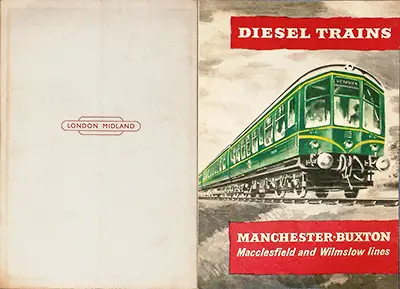
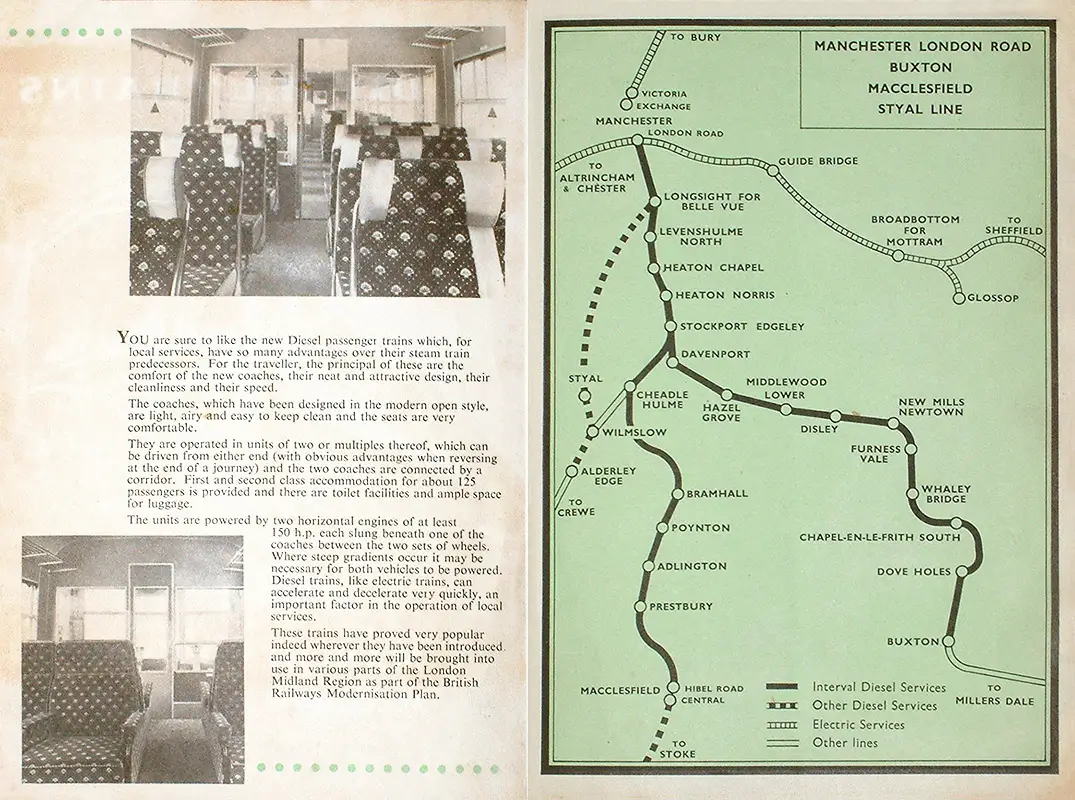
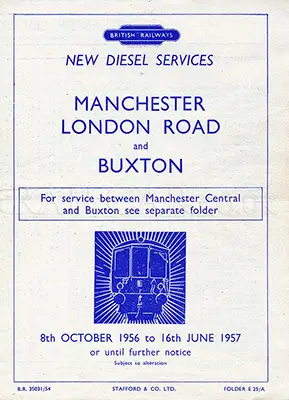
The first timetables used an illustration of a Derby Lightweight front-end and covered the period 8th October 1956 to 16 June 1957.
Buxton
The Manchester London Road - Buxton schedule would be close to an hourly interval service, with steam still in operation on rush-hour workings. The journey time between Stockport and Buxton was improved between four and six minutes, but as the diesel service stopped at all stations between London Road and Stockport, the overall journey time could be longer than the previous timetable in which some steam services ran non-stop on this part of the journey.
Services were normally operated by a single two-car set, with both the power-twins and power-trailers being noted.[5]
Sets would also begin to work the Sunday service on the Buxton-Millers Dale line (the full takeover was not until October 1957). On the first day, October 14th, a power twin was noted in use. Photos of this and the first day of Buxton services can be found on David Hey's website.
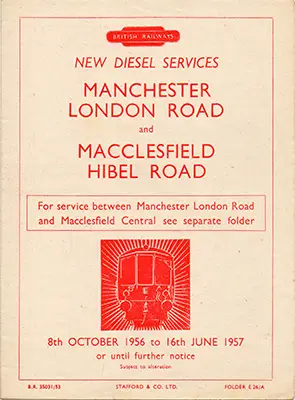
Macclesfield
These were also mainly an hourly interval service. Some of the existing steam services to Stoke and Stafford were retimed to fit into the interval service, and some of the steam services would now only make a Stockport stop between Macclesfield and Manchester, the DMUs providing a connection at Macclesfield for other intermediate stations.
The route taken was via Cheadle Hulme and Adlington. Services were normally operated by two two-car sets, two power-trailers being normal, but one set being a power-twin was not unknown and even two power twins — such as 79176/90/71/86 noted during the week ending 17th November 1956.[5]
Styal
The railcars were also introduced to the Styal line to Wilmslow and Alderley Edge in this timetable but due to electrification engineering work this was to existing timings. The section between Styal and Wilmslow would closed by the end of the month for six weeks for lowering trackbed under bridges[5]. A crossover was added at Styal to allow the DMUs to reverse for this period (October 15 to November 23) and a bus service operated between Wilmslow and Styal[6].
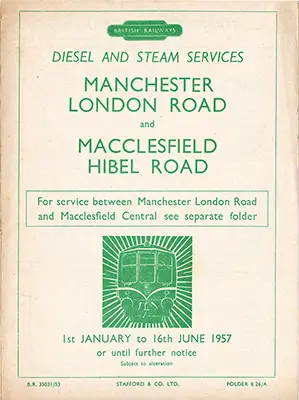
Revised Timetable
Despite the October 1956 timetables covering the period to June 1957, a revised timetable was issued for the Hibel Road service effective 1st January 1957. It was now promoted as "Diesel and Steam Services" — this was probably a result of the national fuel oil crisis at the time requiring some services to revert to steam.
Blue Square arrivals and Yellow Diamond departures
In April 1957 Blue Square units began to arrive at Longsight with four Rolls-Royce powered Met-Camm sets and two three-car BRC&W sets delivered that month. These were soon put into traffic and they allowed four of the Lightweight power-trailer sets to return to Llandudno, two in April (79172/6) and two in May (79177/80).
The incompatibilities between the two types was a problem in this operating area where diagrams required sets to be joined together during part of the day. The Blue Square sets would soon become the dominant breed, and these new types formally took over the Buxton and Macclesfield Hibel Road services with the June 17th timetable. All the remaining Longsight Derby Lightweights would move to Llandudno Junction in June 1957, except M79171 which has a transfer date of September.
Longsight depot would receive some Lightweight sets for a brief spell a decade later in 1967, but the story continues at another depot in the city.
Gorton: for Hayfield and Macclesfield Central
ER sets
Between March and May 1957 Gorton (39A), then an Eastern Region depot, received eleven Derby Lightweight sets (79024-34 with 79616-25/250) from Lincoln where they had been replaced by blue square units. These would allow another part of the Manchester Part One scheme to begin in the "Eastern Operation Area" and were noted as being on loan until more LMR units were available.
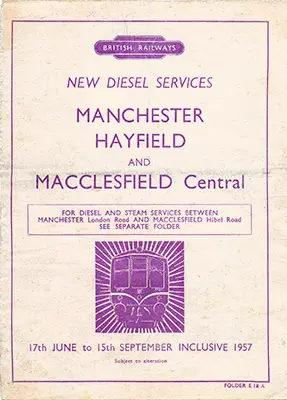
With the new timetable on 17th June 1957 these sets were introduced on services from London Road to Hayfield and Macclesfield Central. This, with the exception of rush hour services where steam-working continued, more or less eliminated steam from the ex-LNER side of London Road station.
The route taken to Macclesfield differed considerably from the Hibel Road services the Longsight sets had used — these headed east from London Road to Guide Bridge then south through Hyde, Romiley, Rose Hill and Bollington. They kept the irregular times of the former steam service. Hayfield services ran via Belle Vue and Reddish North. The two services provided a half-hourly service outwith rush hour between Manchester and Marple.
Images of the ER sets in London Road can be found on other websites — the RailOnline photo library has E79616 on April 1 1957 (before introduction so possibly driver training?) and the RCTS Zenfolio website has E79025 and E79617 on August 4th.
LMR sets
With the North Wales summer season over and probably in anticipation of the forthcoming Regional boundary change, late 1957 saw eleven LMR sets arrive at Gorton from Llandudno Junction and Monument Lane (the power cars were 79171-81, the trailers assumed to be 79672-82). This allowed the eleven ex-Lincoln sets to move to Norwich (ten sets) and Stratford (one set).
Gorton depot was transferred to the LMR on Saturday 1/2/58 becoming 9H, with stock initially considered as on loan from the ER to LMR then permanently transferred from Sunday 23/2/58. It was re-coded as 9G a few weeks later in April.

The image shows M79173 + M79674 in Manchester London Road, date unknown. Stuart Mackay Collection.
A further two sets arrived in January 1959 from Northwich with power cars 79169/70 — meaning for the first time the area now had the full batch of thirteen sets built for the Part One scheme. It was short-lived though, two sets would leave in mid-1959, one to Speke Junction and one to Brunswick, these being the highest number two sets (79180/1).
In October 1959 the eleven sets were re-allocated to another Manchester depot: Reddish.
Newton Heath
In September 1958 the Bury allocation of DMUs (seven Met-Camm Lightweights, a power-trailer and a power-twin Derby Lightweight) were transferred to Newton Heath depot, stabled alongside Cravens power-twins which were part of the "Manchester Part Two" scheme. The Yellow Diamond sets kept to their same duties, and very soon afterwards the power-twin 79185/90 would move to Brunswick.
Three sets from the West Cumberland batch (the power cars being 79013-5) arrived at the depot in September 1964. At the end of that year there would be an influx of Blue Square vehicles at Newton Heath (such as Met-Camms from Monument Lane, BRC&W sets from Cockshute and Etches Park) and the Bury services were switched over to Blue Square sets. The Derby Lightweight power-trailer set (79142-79684) and one of the Met-Camm sets were transferred to Reddish in December 1964, the remainder followed in February, except the three West Cumberland sets which returned to Carlisle.
Now left with just Blue Square vehicles, the depot would have Yellow Diamond sets again when the three Cravens parcels sets arrived there in 1969, but now all the Manchester Yellow Diamond passenger sets were concentrated at Reddish depot.
Reddish
Reddish was a sub-depot to Gorton and in November 1958 was still an ER depot. The minutes of the Diesel Trains Committee on 5/11/58 noted that it was under consideration for transfer to the LMR and in the meantime they had reached agreement with the Eastern Region that 30 two-car sets and the two Blue Pullmans could be maintained there.
The depot would be transferred to the LMR, but did not seem to be given a shed code until September 1963 when it became 9C.
It would receive 27 Derby Lightweight sets in October 1959, seven from Speke Junction (79010/121-3/6/7/180), two from Brunswick (79141/81), seven from Northwich (79143-9) and the eleven Gorton sets (79169-79).
From 2nd November 1959 fourteen sets were introduced to steam timings on the Manchester - Hayfield / Macclesfield route, augmenting the thirteen already covering some of the services.[7]
More arrivals in December were 79124 from Carlisle and 79125/8-30 from Llandudno Junction, in January 1960 79131/2 also arrived from Llandudno Junction. All with accompanying trailers.
The depot now had 34 Derby Lightweight power trailer sets, the largest allocation of the type at any depot at the time. This large influx of units helped with the elimination of steam from more local services.

With electrification work in progress, the image shows two two-car Derby Lightweight DMUs arrive at Manchester London Road with the 3.0pm ex-Marple on 9th April 1960. Michael Mensing.
Electrification work at Manchester London Road saw DMU services being turned around at Ashburys, between February and April 23 1960. The station would be renamed as Piccadilly that year.
New Mills Collision
On 12th October 1960 three Derby Lightweight twin units, working the 3.50pm Piccadilly to New Mills Central, collided with the rear of a goods train hauled by a Class 8F (48443), which was standing at New Mills (Central) Up home signal. The DMU had passed the Strines Station starting signal at danger.
Thankfully only three people were injured. The leading power car M79170 was wrecked and would be withdrawn; the following trailer car was crumpled by colliding with the leading car. The two rear units were little damaged. Images of the crash can be found on this New Mills website.
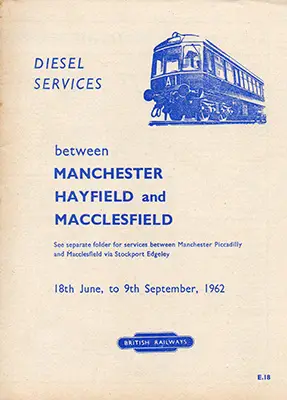

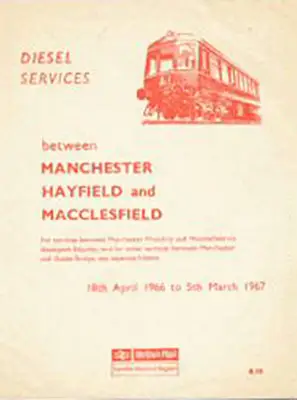
Above: more sample timetable covers for the Hayfield/Macclesfield services: - 18th June to 9th June 1962; 7th September 1964 until further notice; and 18th April 1966 to 5th March 1967.

Reddish depot was also responsible for the Midland Pullman sets, one of which is seen alongside a Derby Lightweight on the depot, date unknown. Ian McDonald Collection.
The reduction of the Manchester Derby Lightweight fleet started in December 1964. That month M79142, the vehicle that so far had been working with the Met-Camm Lightweights on Bury services, moved from Newton Heath (with its trailer) to join its siblings at Reddish along with one of the MCL sets. This allowed 79131/2 (and with 79653/66) to move to Watford and Bletchley.
The following month in January 1965 79010/121-7 (and trailers) would move north to Carlisle Upperby, replaced by the arrival of the remainder of the Met-Camm Lightweights.
The Met-Camm Lightweights would be pooled with the Derby Lightweights on the same duties such as Hayfield and there was even a hybrid set formed. A destination blind that survives from these sets show the services they might be found working at the time.

The first image shows two two-car Derby Lightweight sets seen at Manchester Piccadilly. Date unknown. David Faircloth.

In the next image M79173 is the power car in the two-car Derby Lightweight set seen north of Strines on a Manchester - Hayfield service, 19th June 1965. Michael Mensing.
A surprise arrival in mid-1966 was M79127 loan from Upperby (presumably with a trailer).
1967
Reddish depot lost its diesel unit allocation in March 1967. The diesel Pullman units had moved on with the end of the Midland Pullman service.
Blue Square units would begin take over the Yellow Diamond services.
M79130/44/5/8/77/9-80-1 had already departed, moving to Upperby in January. M79146/171 followed in February, then M79127/9/42 in March. The remaining sets M79141/3/7/49/169/72-6/8, and the Met-Camm Lightweights, stayed in the Manchester area being transferred to Longsight.
Longsight - the final months
In early 1967 Longsight had a major shuffle of its DMU Allocation. It lost all of its three-car BRC&W sets (the power-trailers remained), 19 moving to Newton Heath and one to Buxton. Blue Square Derby Lightweights (Class 108s) arrived from Chester and Newton Heath. Twelve Yellow Diamond sets arrived in March — six Met-Camm Lightweights (with power cars 79077-82) and six Derby Lightweights (with power cars 79141/3/7/49/169/72-6/8) from Reddish.
Blue Square Derby Lightweight and BRC&W type power-trailer sets would now operate the Hayfield services.
For the Yellow Diamond sets their stay at Longsight was brief, some (79141/7/72) being withdrawn almost immediately, the remainder would be withdrawn in July, just one (M79175) would survive moving to Carlisle Upperby.
Thus ended the Derby Lightweight story in the Manchester area. What remained of the LMR Derby Lightweight fleet was now concentrated at Carlisle and Bletchley.
References
- ⋏ p202 July 1956 Railway Observer
- ⋏ p236 August 1956 Railway Observer
- ⋏ p259 September 1956 Railway Observer
- ⋏ p289 October 1956 Railway Observer
- ⋏ a b c "Manchester Diesel Services", D.F. Tee, p289 October 1956 Railway Observer
- ⋏ p582 Trains Illustrated December 1956
- ⋏ Item 726 (b) Diesel Trains Committee 27/11/59 meeting
The Railway Observer is the journal of the Railway Correspondence and Travel Society
Summary
Description
- Single cars
- Four-car sets
Drivers Instructions
Numbering
Liveries
Operations
- West Cumberland
- Lincolnshire
- East Anglia
- North Eastern Region
- Buckingham - Banbury
- Manchester
Non-Passenger Use
- Special Saloon
- Ultrasonic Test Train
Images
Details about preserved Derby Lightweights can be found here.


